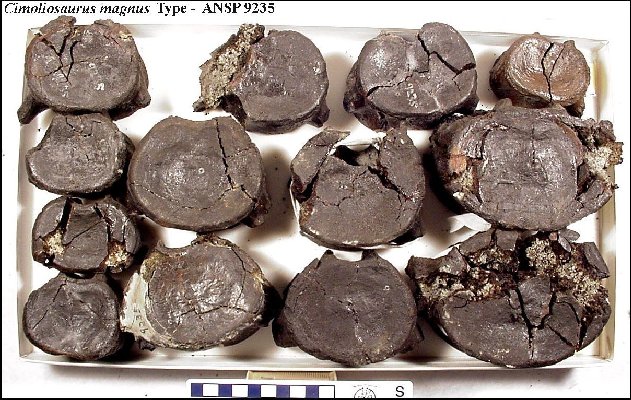| 1851.]
325 (previous non-Leidy text on this page omitted)
Dr. Leidy exhibited a number of fossil reptilian and mammalian
remains which he characterized verbally as follows :
Cimoliasaurus magnus Leidy. A saurian established upon
thirteen vertebræ, apparently from one individual, found in the Green Sand of New Jersey,
and preserved in the Museum of the Academy. Two of the vertebræ are posterior dorsal, the
remainder lumbar. All of them have the processes broken off, excepting one of the dorsal,
which still preserves its transverse processes nearly entire.
The vertebral bodies are broader than they are long, being
compressed cylindroidal in form, gradually expanding from their middle to the angular edge
of the articular surface. The latter are slightly concave, about one-half the depth of
those of Poecilopleuron Bucklandii, Delsch., with the centre a little prominent,
and becoming slightly convex towards the edges.
The transverse processes remaining in one of the specimens of
dorsal vertebræ are prominent, thick, irregularly cylindroid tubercles, projecting from
the middle of the side of the vertebral body, with an oblique articular facet for the rib.
In the lumbar vertebræ the transverse processes incline downwards from the lower part of
the bodies laterally, as in Mososaurus [sic].
326
[December,
Measurements of the largest dorsal vertebræ.
Length of body,
2 3/4 inches
Breadth of body at articular faces
4 1/2 inches
Heighth of body at articular faces
3 1/2 inches
Depth of articular faces,
2 lines [1/6 in]
Length of transverse processes,
1 inch
Diameter of transverse processes,
1 1/2 inch
Breadth of spinal canal,
1 inch
Measurements of the smallest lumbar vertebra.
Length of body
2 inches.
Breadth of body
2 3/4 inches
Heighth of body
2 in. 10 lines
Depth of articular surfaces,
2 1/2 lines
Discosaurus vetustus Leidy. A saurian founded upon a single vertebra
with the processes broken away, obtained by Mr. Joseph Jones from the cretaceous formation
of Alabama.
The body is about as large, and has a general resemblance to that
of Plesiosaurus pachyomus, Owen, represented in fig. 3, tab. xx, of the Monograph
on the fossil reptiles of the Cretaceous Formation. It differs most remarkably from the
vertebral bodies of Plesiosaurus, in the articular faces forming distinct concave
disks, separated from the body by a constriction or short neck. The body is relatively
much broader in relation to its length than in Plesiosaurus. The specimen is a
cervical vertebra. Upon each side it has a deep, concave, transversely oval, costal pit,
with a very prominent, sharp border.
Measurements.
Length of body,
2 inches.
Breadth of body,
2 3/4 inches.
Heighth of body
Depth of articular surfaces,
2 1/2 lines.
Transverse diameter of costal pit,
1 1/4 inches.
Vertical diameter of costal pit,
11 lines.
Depth of costal pit,
4 lines
The fragment of a vertebra described by Dr. Dekay in the Annals
Lyceum of Nat. Hist. of New York, Vol. 3, p. 165 and represented in pl. 3, fig. 11, from
the Green Sand of New, Jersey, and observed by that gentleman to be allied to the Plesiosaurus,
probably belongs to the Discosaurus vetustus.
The vertebra described by Dr. Harlan in the Journal of this
Academy, Vol. 4, p. 232, and represented in pl. xiv, fig. 1, was referred to the Plesiosaurus.
The specimen was from the Green Sand of New Jersey, and is preserved in the cabinet of the
Academy. It does not belong to a saurian, but is a posterior dorsal vertebra of a cetacean
allied to the Delphinus. The vertebral body is relatively twice the length of
what it is found to be in the latter. The transverse process is also relatively short and
broad; at its extremity it has an articular facet for the head of a rib.
The vertebra is probably the type of a form existing in a distinct
genus of ancient Cetacea, for which I propose the name Priscodelphinus. The
species I
1851.]
327
dedicate to the memory of Harlan, under the name Priscodelphinus Harlani
Leidy.
In the collection of the Academy there are preserved two caudal
vertebra of a young cetacean, from the Green Sand of Jersey. These specimens are larger
than the dorsal vertebra just described, but, from the length of their bodies, and the
width antero-posteriorly of the neural arch, I suspect them to belong to the same genus of
the latter, but a larger species, for which I propose the name Priscodelphinus
grandævus Leidy.
Measurements of the posterior dorsal vertebra of P. Harlani.
Length of body,
2 inches.
Breadth of articular surfaces,
8 lines.
Length of transverse process,
1 1/2 inches.
Measurements of two caudal vertebræ of P. grandævus.
Length of body,
2 3/4 inches.
Breadth of epiphysial surfaces,
2 1/4 inches
The two species of Priscodelphinus possess more than ordinary
interest, from their being the first mammalia which have been discovered in the cretaceous
formations.
(... remainder of Leidy note omitted) |

